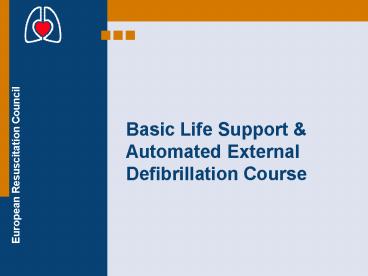Basic Life Support - PowerPoint PPT Presentation
1 / 44
Title:
Basic Life Support
Description:
At the end of the winter term. participants should be able to ... Described as barely, heavy, noisy or gasping breathing. Recognise as a sign of cardiac arrest ... – PowerPoint PPT presentation
Number of Views:1054
Avg rating:3.0/5.0
Title: Basic Life Support
1
Basic Life Support Automated External
Defibrillation Course
2
- www.erc.eduwww.resus.org.uk
- Resuscitation (2005) 67 Supplement
- Resuscitation (2005) 67
3
OBJECTIVES
- At the end of the winter term
- participants should be able to demonstrate
- How to assess the collapsed victim.
- How to perform chest compression and rescue
breathing. - How to place an unconscious breathing victim in
the recovery position.
4
BACKGROUND
- Approximately 700,000 cardiac arrests per year in
Europe - Survival to hospital discharge presently
approximately 5-10 - Bystander CPR vital intervention before arrival
of emergency services - Early resuscitation and prompt defibrillation
(within 1-2 minutes) can result in gt60 survival
5
Most frequent causes of cardiac arrest
Poruchy rytmu pri AIM
6
Most common causes of cardiac arrest
- 1. place IHD...MI...,
- Trauma
- Asphyxia
- Poisoning
- Drowning
- Hypotermia...
Poruchy rytmu pri AIM
7
CHAIN OF SURVIVAL
8
BASIC LIFE SUPPORT (BLS)
- Airway
- Breathing
- Circulation (CAB)
9
Approach safely
Check response
Shout for help
Open airway
Check breathing
Call 112
30 chest compressions
2 rescue breaths
10
APPROACH SAFELY!
- Scene
- Rescuer
- Victim
- Bystanders
Approach safely
Check response
Shout for help
Open airway
Check breathing
Call 112
30 chest compressions
2 rescue breaths
11
CHECK RESPONSE
Approach safely
Check response
Shout for help
Open airway
Check breathing
Call 112
30 chest compressions
2 rescue breaths
12
CHECK RESPONSE
- Shake shoulders gently
- Ask Are you all right?
- If he responds
- Leave as you find him.
- Find out what is wrong.
- Reassess regularly.
13
SHOUT FOR HELP
Approach safely
Check response
Shout for help
Open airway
Check breathing
Call 112
30 chest compressions
2 rescue breaths
14
OPEN AIRWAY
Approach safely
Check response
Shout for help
Open airway
Check breathing
Call 112
30 chest compressions
2 rescue breaths
15
AIRWAY OPENING BY NECK EXTENSION
16
CHECK BREATHING
Approach safely
Check response
Shout for help
Open airway
Check breathing
Call 112
30 chest compressions
2 rescue breaths
17
CHECK BREATHING
- Look, listen and feel for NORMAL breathing
- Do not confuse agonal breathing with NORMAL
breathing
18
AGONAL BREATHING
- Occurs shortly after the heart stops
- in up to 40 of cardiac arrests
- Described as barely, heavy, noisy or gasping
breathing - Recognise as a sign of cardiac arrest
19
Approach safely
Check response
Shout for help
Open airway
Check breathing
Call 112
30 chest compressions
2 rescue breaths
20
30 CHEST COMPRESSIONS
Approach safely
Check response
Shout for help
Open airway
Check breathing
Call 112
30 chest compressions
2 rescue breaths
21
CHEST COMPRESSIONS
- Place the heel of one hand in the centre of the
chest - Place other hand on top
- Interlock fingers
- Compress the chest
- Rate 100 min-1
- Depth 4-5 cm
- Equal compression relaxation
- When possible change CPR operator every 2 min
22
30 2
Handley A.J., Koster R., Monsieurs K., Perkins
G.D., Davies S., Bossaert L. European
Resuscitation Council Guidelines for
Resuscitation 2005. Section 2. Adult basic life
support and use of automated external
defibrillators Resuscitation (2005) 67S1, S7S23
23
RESCUE BREATHS
Approach safely
Check response
Shout for help
Open airway
Check breathing
Call 112
30 chest compressions
2 rescue breaths
24
RESCUE BREATHS
- Pinch the nose
- Take a normal breath
- Place lips over mouth
- Blow until the chest rises
- Take about 1 second
- Allow chest to fall
- Repeat
25
CONTINUE CPR
- 30 2
26
POTENTIALLY REVERSIBLE CAUSES (5 Hs 5 Ts)
- Hypoxia
- Hypovolemia
- Hypothermia
- Hyper/hypoKand metabolic disorders
- H ions (acidosis)
- Tension pneumothorax
- Tamponade
- Toxic/therap. disturbances
- Thrombosis coronary
- Thrombosis pulmonary
27
Approach safely
Check response
Shout for help
Open airway
Check breathing
Call 112
30 chest compressions
2 rescue breaths
28
IF VICTIM STARTS TO BREATHE NORMALLY PLACE IN
RECOVERY POSITION
29
(No Transcript)
30
DEFIBRILLATION
31
ANY QUESTIONS?
32
Approach safely
Check response
Shout for help
Open airway
Check breathing
Call 112
Attach AED
Follow voice prompts
33
SWITCH ON AED
- Some AEDs will automatically switch themselves on
when the lid is opened
34
ATTACH PADS TO CASUALTYS BARE CHEST
35
ANALYSING RHYTHM DO NOT TOUCH VICTIM
36
SHOCK INDICATED
- Stand clear
- Deliver shock
37
SHOCK DELIVEREDFOLLOW AED INSTRUCTIONS
30 2
38
NO SHOCK ADVISEDFOLLOW AED INSTRUCTIONS
30 2
39
IF VICTIM STARTS TO BREATHE NORMALLY PLACE IN
RECOVERY POSITION
40
(No Transcript)
41
CPR IN CHILDREN
- Adult CPR techniques can be used on children
- Compressions 1/3 of the depth of the chest
42
AED IN CHILDREN
- Age gt 8 years
- use adult AED
- Age 1-8 years
- use paediatric pads / settings if available
(otherwise use adult mode) - Age lt 1 year
- use only if manufacturer instructions indicate it
is safe
43
ANY QUESTIONS?
44
Approach safely
Approach safely
Check response
Check response
Shout for help
Shout for help
Open airway
Open airway
Check breathing
Check breathing
Call 112
Call 112
30 chest compressions
Attach AED
2 rescue breaths
Follow voice prompts































